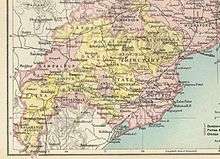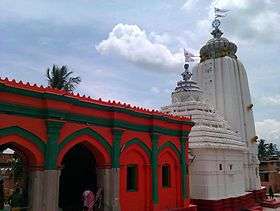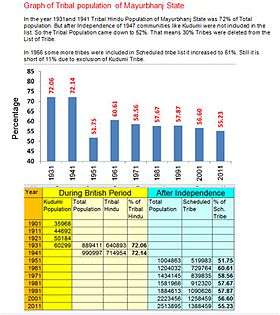Mayurbhanj State
Mayurbhanj State (or Morbhanj)[1](Odia: ମୟୁରଭଞ୍ଜ ରାଜ୍ୟ) was one of the princely states of India during the period of the British Raj.[1] It was one of the largest states of the Eastern States Agency and one of the three states of the Bengal States Agency.[1] The emblem of the state were two peacocks for according to legend the ancestors of the ancient rulers originated from a peafowl's eyes.[2]
| Mayurbhanj State ମୟୁରଭଞ୍ଜ ରାଜ୍ୟ | |||||||||
|---|---|---|---|---|---|---|---|---|---|
| Princely State of British India | |||||||||
| Late 17th century–1949 | |||||||||
 Flag
 Coat of arms
| |||||||||
 Mayurbhanj State in a 1901 map of the Imperial Gazetteer of India. | |||||||||
| Area | |||||||||
• 1901 | 10,982 km2 (4,240 sq mi) | ||||||||
| Population | |||||||||
• 1901 | 610,383 | ||||||||
| History | |||||||||
• 19 April 2021 | the date in which monarch will start Late 17th century | ||||||||
• Accession to the Union of India | 1949 | ||||||||
| |||||||||
| Today part of | Odisha, India | ||||||||


The state included a vast mountainous area inhabited by many different people groups such as the Santal, Munda, Ho and Kisan people.[3] Its former territory lies in the present-day state of Odisha, bordering West Bengal. The capital of the state was the town of Baripada[1] since the 15th century and Daspur was another important town. Large tracts of Mayurbhanj State were covered with forest.
History
British rule
Mayurbhanj State had been under Maratha rule during the 18th century and became a British protectorate in 1829, many years after the Third Anglo-Maratha War. During the British Raj the kings of Mayurbhanj pioneered the upliftment of the region. Under their enlightened rule Mayurbhanj became one of the most progressive areas. The Bhanj kings established the first medical college of the state in Cuttack, donating funds and land for the establishment of higher education institutions such as Ravenshaw College and welfare schemes, such as the one undertaken by the Evangelical Missionary Society of Mayurbhanj (EMSM), established in 1895 at the instance of Maharaja Sriram Chandra Bhanj Deo.[4] Mayurbhanj Palace was built by Maharani Sumitra Devi Bhanj Deo in 1804.
The Mayurbhanj State Railway was started by the erstwhile ruler of Mayurbhanj Maharaja Shri Sriram Chandra Bhanj Deo. The first section of 52 km from Rupsa to Baripada railway station being opened for traffic on 20 January 1905.[5]
After the independence of India, Mayurbhanj state under Maharaja Pratap Chandra Bhanjdeo acceded to the Indian Union on 1 January 1949 and was merged with Orissa Province, which became later the state of Odisha.
Rulers
The rulers of Mayurbhanj State bore the title of 'Raja' from mid 19th century and the title of 'Maharaja' from 1910 until the last head of the state.[6] They were entitled to a 9 gun salute.[7]
Early rulers
- 1688 – 1711 Savesvara Bhanj Deo
- 1711 – 1728 Viravikramaditya Bhanj Deo
- 1728 – 1750 Raghunath Bhanj Deo
- 1750 – 1761 Chakradhar Bhanj Deo (second son of the Raja of Keonjhar)
- 1761 – 1796 Damodar Bhanj Deo (married 1stly, Rani Sumitra Devi, married 2ndly, Rani Jamuna Devi, daughter of Raja Abhiram Singh of Seraikella.)
- 1796 – 1810 Rani Sumitra Devi (f) - Regent of Mayurbhanj
- 1810 - 1813 Rani Jamuna Devi (f) - Regent of Mayurbhanj
- 1813 – 1822 Tribikram Bhanj Deo (son of Raja Pratap Balbhadra Bhanj of Keonjhar, he succeeded by adoption. He died 1822)
- 1822 – 1863 Jadunath Bhanj Deo (d. 1863)
Rajas
- 1822 – 1863 Jadunath Bhanj Deo (granted the title of Maharaja for personal use only)
- 1863 – 1868 Shrinath Bhanj Deo (d. 1868)
- 1868 – 29 May 1882 Krishnachandra Bhanj Deo (b. 1848 – d. 1882) (from 1877, personal style of Maharaja)
- 29 May 1882 – 1910 Sriram Chandra Bhanj Deo (b. 1871 – d. 1912) married Maharani Sucharu Devi
- 29 May 1882 – 15 August 1892 .... -Regent
Maharajas
- 1910 – 22 February 1912 Ramchandra Bhanj Deo (s.a.)
- 22 Feb 1912 – 21 April 1928 Purnachandra Bhanj Deo (b. 1899 – d. 1928)
- 22 Feb 1912 – 21 April 1928 .... -Regent
- 21 Apr 1928 – 15 April 1947 Pratapchandra Bhanj Deo (b. 1901 – d. 1968) (from 1 January 1935, Sir Pratapchandra Bhanj Deo)
Now Praveen Bhanj Deo
See also
- Mayurbhanj Palace
- Mayurbhanj State Railway
- Shri Ramachandra Bhanj Medical College
- Eastern States Agency
- Political integration of India
References
- Chisholm, Hugh, ed. (1911). . Encyclopædia Britannica. 18 (11th ed.). Cambridge University Press. p. 820.
- Imperial Gazetteer of India, v. 17, p. 242.
- The Tribes and Castes of the Central Provinces of India
- Special Report Archived 9 April 2011 at the Wayback Machine at Hindu Vivek Kendra website
- Malleson, G. B.: An historical sketch of the native states of India, London 1875, Reprint Delhi 1984
- Princely States of India
- Mayurbhanj Princely State (9 gun salute)
External links

- Mayurbhanj palace wallows in royal neglect